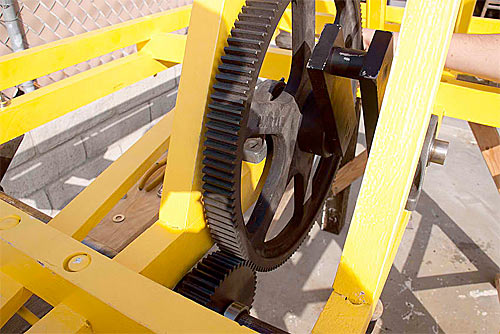|
Railroad Handcar Replica My handcar is a replica of a circa 1890's handcar. Hand car technology did not change much over the years. While it looks very much like an original there are some differences that make it identifiable as a replica. 1. Parts are machined, not cast. 2. Wheels are manufactured by Fairmont post 1910. These are identified by having fewer spokes than the original wheels. I am looking for original wheels if anyone comes across a set they want to part with. 3. My gears are modern and have more teeth allowing for smoother operation. 4. My deck is white oak, while the original cars used lighter weight and less brittle fir and pine. 5. Original handcars use friction bearings, where my replica uses roller bearings. Roller bearings require no maintenance, where friction bearing require regular oiling. For a period in the early 1900's ball bearings were used before friction bearings became the standard. 6. I have modern hardware fasteners on my replica, though I have used period fasteners on most visible areas. My handcar was built using Bruce Carpenter's handcar plans. His plans are about as good as you will find available. Warning, this project is not for the undedicated as it requires advanced wood working, machining, and welding skills to complete. In my case I contracted out the welding to a local shop. I fabricated some of the machined parts myself, and had the help of a local machinist who helped me with the more difficult parts. I did the woodworking with the help of a friend and my grandfather. I started on the project when I was 13, and finished it nine months later when I was 14. There were lots of snags along the way including not so honest people who sold me axle parts that were bent. Thankfully, I found a straightening shop to fix one, and the other was scrapped. It cost me about $5000 to build the handcar which I paid for mostly with money I earned from selling model train items on ebay. I also manufacture and sell HO scale Joshua Trees which I sell on my other web site. Construction Photos  Solid white oak frame. White oak is preferable to other woods as it holds up better to the weather than other wood. Sheffield built their cars from ash, while Buda built their cars from Maple. The wood joints are mortise and tenon.  My Sheffield replica uses a modern gear with more teeth than the original.  Almost complete. The wheels, hubs, and axles are from a Fairmont motor car. Twenty inch diameter wheels are extremely difficult to come by as motor cars use smaller 16 inch wheels. The ones for my handcar most likely came from a push cart. To be a complete car it must be stocked with a compliment of tools of the period. Shortly after completing the construction I set out to acquire a complete handcar tool collection. My car typically travels with shovels, picks, spike puller bar, spike hammer, track chisel, sledge hammers, wrenches, track guage, water and oil cans, flags, and lanterns for night travel. There are not a lot of opportunties to run my handcar where I live. As a result we layed 75 feet of track on the side yard of my house which is better than nothing. The rail is 75 pounds to the yard and was placed on pressure treated lumber with paver stones on top for the side yard, and regular railroad ties for the rear of the yard. The grade is 1%, with a short section of 1.5% at the rear of the yard. I have had a few opportunities to run on a real ralroad. My record to date is 14 miles in one day and I could have probably gone twice as far. If you own a shortline I would welcome the opportunity to run on your railroad in exchange for work. I am looking for a new project and would like to find an original handcar or velocipede in need of rebuilding. If you have parts around you would be willing to sell drop me a line. I am especially looking for 20 inch diameter wheels. Return to replica main page |
Copyright 2012, Mason Clark